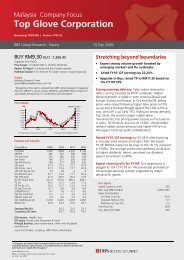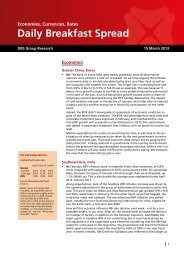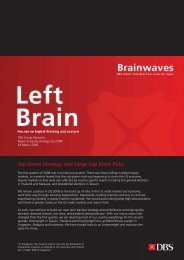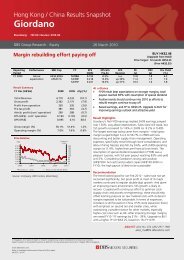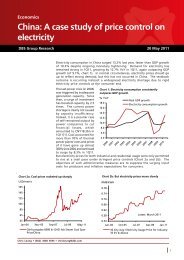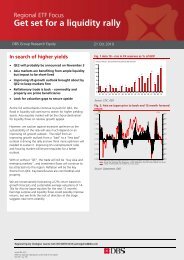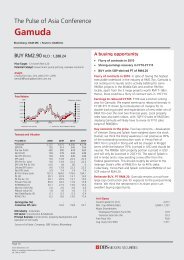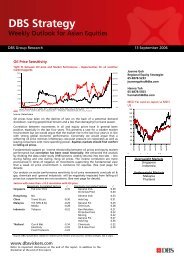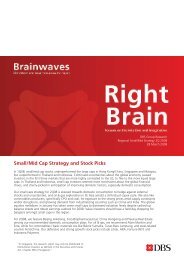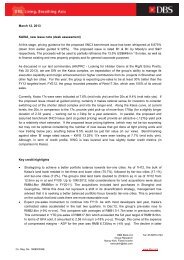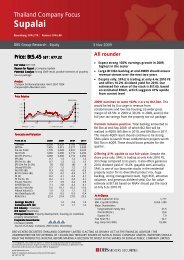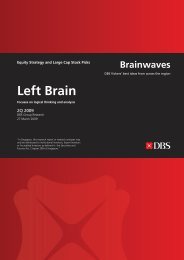Left Brain Right B - the DBS Vickers Securities Equities Research
Left Brain Right B - the DBS Vickers Securities Equities Research
Left Brain Right B - the DBS Vickers Securities Equities Research
Create successful ePaper yourself
Turn your PDF publications into a flip-book with our unique Google optimized e-Paper software.
Regional Equity Strategy 4Q 2009<br />
Strategy Overview: Asia Equity<br />
Taiwan: Ideals vs reality (Ma Tie Ying, matieying@dbs.com, extracted from “Economics – Markets – Strategy,<br />
4Q09” dated 17 September 2009)<br />
• Taiwan’s recession was driven by exports. They are<br />
now driving recovery. We expect <strong>the</strong> upturn in global<br />
demand to continue and for this to translate into<br />
fur<strong>the</strong>r growth in production and employment<br />
• There are high expectations about Taiwan’s longterm<br />
economic prospects as a result of cross-strait<br />
liberalization, which have triggered inflows and<br />
revived asset markets. But achieving an ideal<br />
structural recovery will take time<br />
• The central bank will focus on <strong>the</strong> near-term<br />
economic reality, i.e., <strong>the</strong> fact that recovery has been<br />
export-driven and domestic demand remains weak.<br />
We forecast no rate change in <strong>the</strong> rest of this year,<br />
and only modest rate hikes in 1H10<br />
Export driven recovery<br />
The economy expanded 20.7% (QoQ, saar) in 2Q09, ending<br />
four quarters of contraction with <strong>the</strong> second strongest growth<br />
quarter on record.<br />
Exports drove <strong>the</strong> recession and <strong>the</strong>y are now driving recovery.<br />
As of July, <strong>the</strong> volume of export orders has fully returned to its<br />
peak level before global financial crisis broke out. Real exports<br />
and industrial production have also each recouped one half of<br />
<strong>the</strong>ir respective losses during <strong>the</strong> crisis. We expect <strong>the</strong> upturn<br />
to be sustained. Chinese demand should continue to grow<br />
steadily in 2H09, so long as China maintains an<br />
accommodative fiscal and monetary policy stance. US demand<br />
is improving and we expect above-potential growth in Q3 and<br />
Q4.<br />
The recovery in exports should lead to investment, especially<br />
for manufacturers in <strong>the</strong> export-oriented tech industry.<br />
Already, imports of machinery and electrical equipments have<br />
made a decisive turn in 2Q09 and continued to edge up in July.<br />
Gross fixed capital formation fell by 40% in <strong>the</strong> three quarters<br />
ending 1Q09, even more than <strong>the</strong> 30% drop in exports. This<br />
inspite of <strong>the</strong> fact <strong>the</strong>re was little overcapacity to begin with.<br />
Corporates have been unenthusiastic about capital spending<br />
ever since 2001, preferring to invest in <strong>the</strong> mainland instead<br />
following China’s accession to WTO. Political chaos at home<br />
didn’t help ei<strong>the</strong>r. Gross fixed capital formation grew by a<br />
mere 0.9% per year between 2001-2007, far below GDP<br />
growth of 3.8%. After <strong>the</strong> drastic capacity reduction during<br />
<strong>the</strong> global crisis last year, <strong>the</strong> ratio of GFCF to GDP slipped<br />
fur<strong>the</strong>r 16.7%, a 20-year low. In short, we think <strong>the</strong> cut in<br />
private sector investment had been excessive and look for a<br />
significant rebound going forward.<br />
A structural recovery still takes time<br />
Uncertainties remain, such as <strong>the</strong> sustainability of policy<br />
stimulus in <strong>the</strong> US and o<strong>the</strong>r advanced economies, and<br />
inflation risk and earlier-than-expected tightening in <strong>the</strong><br />
emerging markets, most importantly in China. Meanwhile,<br />
Taiwan’s structural problem of hollowing-out still exists. The<br />
gap between export orders and exports is large and widening,<br />
due to <strong>the</strong> high ratio of overseas production, especially in<br />
China. To reduce its vulnerability to global shocks, Taiwan will<br />
need to restructure its economy and nurture domestic growth<br />
drivers.<br />
The liberalization of cross-strait relations is widely viewed as a<br />
possible solution. Since last year, cross-strait negotiations have<br />
made good strides in <strong>the</strong> areas of transportation, tourism,<br />
investment and financial sector cooperation. The two sides are<br />
currently mulling fur<strong>the</strong>r steps toward a formal Economic<br />
Cooperation Framework Agreement that would allow free<br />
trade in many goods and services and investment flows across<br />
<strong>the</strong> strait. The effects from <strong>the</strong>se policy initiatives so far are<br />
mainly seen in fund flows and <strong>the</strong> asset markets. In <strong>the</strong> BoP<br />
accounts, for example, local residents’ “currency & deposits”<br />
have been <strong>the</strong> recipient of inflows for six quarters, with <strong>the</strong><br />
cumulative value reaching USD 31bn. Foreign portfolio inflows<br />
have also increased since 2Q09, offsetting <strong>the</strong> rebound in<br />
outward portfolio investment. The TAIEX is up 60% year-todate.<br />
The volume of residential property transaction has also<br />
risen since 1Q09, and home prices (as proxied by <strong>the</strong> Sinyi<br />
index) have rebounded in 2Q09.<br />
Still, <strong>the</strong> ideal scenario would be an expansion in real<br />
investment. Moreover, one that would not be limited to <strong>the</strong><br />
export-oriented tech industry, but occur in a large number of<br />
sectors linked to cross-strait liberalization such as<br />
transportation, retail trade, tourism, finance and construction.<br />
To encourage longer-term investment, ensuring <strong>the</strong> continuity<br />
and timeliness of liberalization policies will be essential. In this<br />
regard, it remains to be seen how well <strong>the</strong> new cabinet<br />
executes a number of tasks including post-typhoon<br />
reconstruction, H1N1 pandemic prevention, fiscal policy exit<br />
strategy and <strong>the</strong> cross-strait negotiations related to a free trade<br />
pact with China.<br />
Page 31<br />
“This report has been re-printed with permission from <strong>DBS</strong> Group <strong>Research</strong><br />
(Regional Equity Strategy) of <strong>DBS</strong> Bank Limited” disclosures on page 37 of this report



